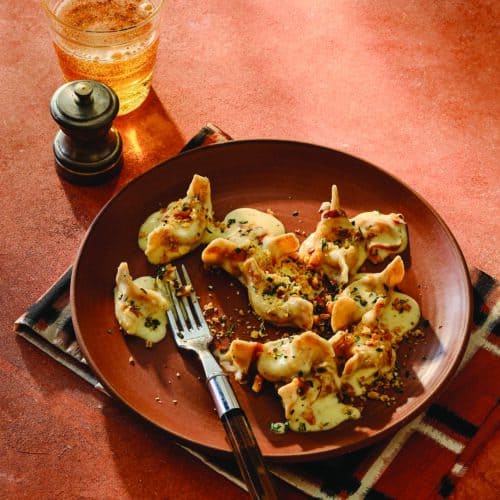Caramelized Onion Cheese Sauce
This caramelized onion cheese sauce is a fan favorite—like “fancy mac and cheese,” Feinstein says. Though technically simple, this dish takes time, but “it’s worth the effort.” A mix of mild and aged cheddars with gruyère (or gouda, Comté, or Emmentaler) provides a “nice balance to the sauce,” she says.
Ingredients
Onions
- 4 tablespoons unsalted butter
- 3 medium yellow onions halved and sliced into ¼-inch halfmoons
- 1/4 cup aged sherry vinegar or balsamic vinegar
- Kosher salt and freshly ground black pepper to taste
Breadcrumbs
- 2 tablespoons extra-virgin olive oil
- 1 cup panko breadcrumbs
- 1 teaspoon roughly chopped fresh thyme
- 1.5 teaspoons minced fresh rosemary
- Kosher salt and freshly ground black pepper to taste
Cheese Sauce
- 2 tablespoons unsalted butter
- 2 tablespoons all-purpose flour
- 1.5 cups whole milk
- 3.5 ounces mild white cheddar grated
- 2.5 ounces aged white cheddar grated
- 2.5 ounces gruyère, gouda, Comté, or Emmentaler grated
- Kosher salt and freshly ground black pepper to taste
Instructions
Onions
- Melt butter in a large Dutch oven or heavy-bottomed sauté pan over medium-high heat. Add onions and mix until thoroughly coated, stirring frequently until soft and translucent, about 15 minutes. Season generously with salt.
- Reduce heat to medium-low and continue cooking, stirring occasionally until golden, between 30 and 60 minutes, depending on your stovetop.
- Once onions begin to stick, reduce heat to low and stir frequently to prevent burning. If needed, deglaze pan with a bit of water. Continue until onions are jammy and a rich, deep brown.
- Increase heat to medium and add vinegar. Cook, stirring frequently, about 2 to 3 minutes. Season with salt and pepper and transfer to a bowl.
Breadcrumbs
- Warm oil in a large skillet over medium-high heat. Add panko and a generous pinch of salt, stirring until completely coated.
- Brown breadcrumbs, about 5 to 7 minutes (if they darken too quickly, turn down the heat). Remove from heat and stir in thyme and rosemary while still warm. Adjust seasoning to taste. Transfer to a bowl and set aside.
Cheese Sauce
- Melt butter in a large Dutch oven or heavy-bottomed sauté pan over medium heat. Whisk in flour to create a roux, scraping up any browned bits from the bottom of the pan. Continue whisking for 1 to 2 minutes, or until the mixture smells nutty and starts to loosen.
- Add milk in a thin, steady stream, and whisk vigorously to combine. (The mixture will get very thick at first but will thin out significantly once all the milk is added.) Whisk frequently until the sauce begins to bubble, then reduce heat to low and stir until the mixture thickens and coats the back of a spoon, 1 to 2 minutes more.
- Add cheese in handfuls, whisking thoroughly after each addition. Remove from heat and add caramelized onions. Season with salt and pepper to taste.
To Serve
- Cook pasta of choice to your liking, reserving 1 cup pasta water.
- Add ¼ cup pasta water to cheese sauce mixture and stir until smooth.
- Transfer pasta directly to sauce and stir to combine, loosening with more pasta water if needed.
- Divide pasta among bowls and top with plenty of breadcrumbs and black pepper.
Notes
A Delicate Balancing Act: Meryl Feinstein’s Tips for Adding Cheese to Sauces
- Be gentle with heat. High heat can cause cheese to seize, clump, and separate. For example, in dishes such as cacio e pepe, rather than adding the cheese directly into a hot pan, mix the cheese with warm pasta water to form a paste before adding to the dish.
